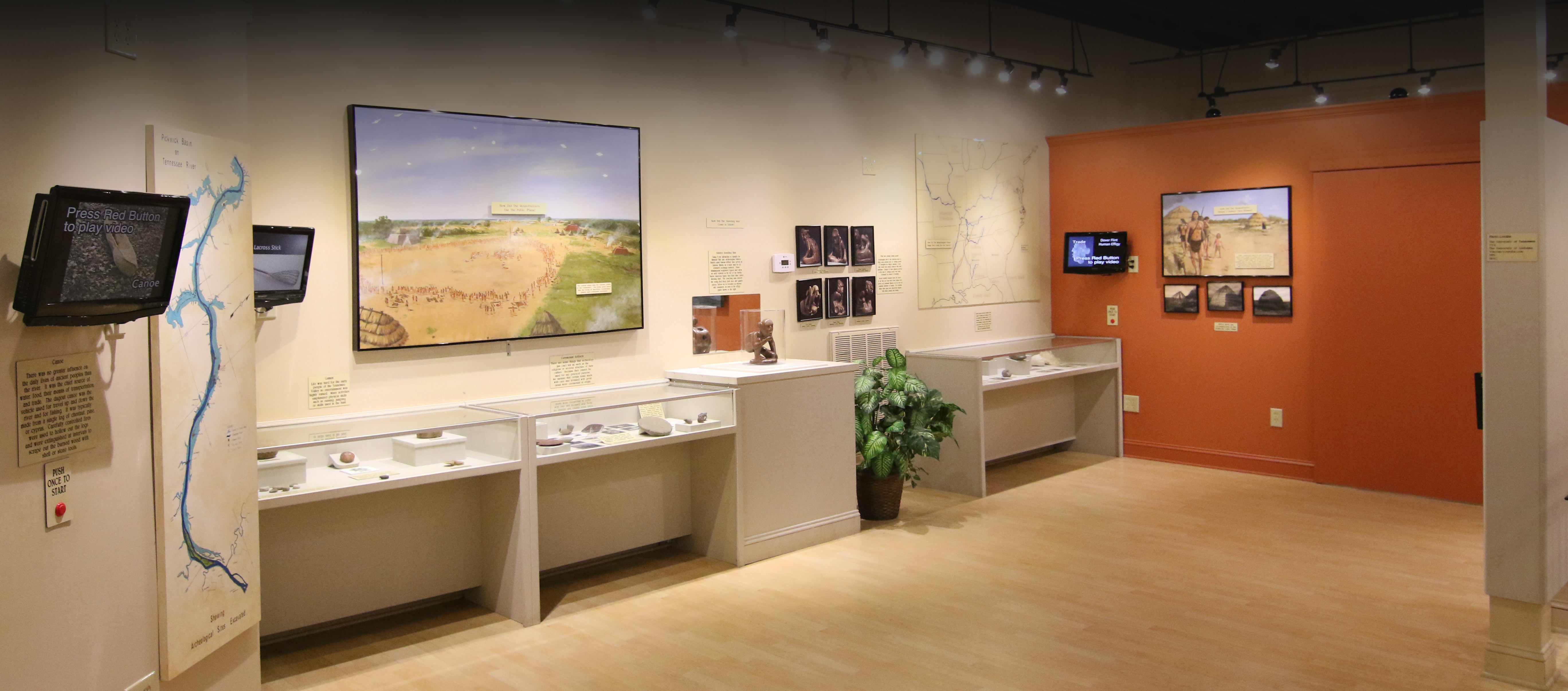The Tennessee River Museum currently houses seven permanent exhibits, each one spotlighting a different period in “Hardin County’s” Tennessee River history. A wide variety of historical treasures can be found under one roof with accompanying user-friendly interactive displays.
Paleontology
Discover the unique abundance of life that filled the Tennessee River Valley in a pre-historic time gone by. This exhibit contains over 200 fossil specimens, along with excavation tools and graphic displays. On display is an insect in amber, the first of which was found in Hardin County. Two very large pieces of petrified wood are also displayed outside the museum in the “Lost Petrified Forest of Savannah” exhibit. Each of these specimens is millions of years old, and they are the largest known in the state of Tennessee, making them truly unique.
Archaeology
On your visit, you’ll have the opportunity to view various types of projectile points found in this region, along with an assortment of pottery, tools, and ceremonial objects, such as the Shiloh Effigy Pipe, which is a one-of-a-kind artifact found on a Mississippian Era Site located on the Shiloh Battlefield. Another point of interest in the archeology area of the museum is the Moundbuilders exhibit with a subfloor replica of an archaeological dig, filled with examples of artifacts commonly found at dig sites as well as tools used by archaeologists.
Pioneers
The Chickasaw Treaties of 1816 &1818 extended Tennessee’s western boundary to the Mississippi River and opened up a rich new agricultural area for settlement. This exhibit includes portraits of some of the first settlers in the area and a collection of period items that were crucial for every settler on the journey to a new homestead.
Trail of Tears
In 1838 the U.S. Army began the forced removal of the Cherokee Nation from their ancestral homes. Over a dozen groups traveled several routes west to Oklahoma on a forced, tragic, march that has come to be known as the Trail of Tears. A group of Native Americans known as the Bell or Treaty Party passed along Savannah’s main street before crossing the Tennessee River. A second group traveled on the Tennessee River, creating one of the few Trail of Tears crossing points at Savannah. The exhibit features a timeline ranging from first contact to modern times along with historic documents.
War on the River
Walking through a half-size replica of the middle gunport of the USS Cairo, you’ll enter an exhibit detailing the importance of major waterways over the course of the Civil War. The Tennessee River was the invasion route used by the Union army. The Federal government authorized the construction of ironclad gunboats to escort steamers that would ferry troops and equipment into Confederate territory. With a meager road network, these swift-running highways afforded huge strategic advantages. The mobility and heavy firepower of the gunboats were used to multiply the ground-taking capability of the infantry. The exhibit features artifacts from the ironclad USS Cairo, accoutrements, arms, and the most complete Shiloh artillery projectile collection in existence.
The Golden Age of Steamboats
The river is still the best road and steam is the way to go! This exhibit highlights the historic Tennessee Riverboat trade, complete with a pilothouse replica and whisper tube. View items from the St. Louis and Tennessee River Packet Company, artifacts from the sunken City of Florence steamboat, photos, and other river-related items.
Musseling
This exhibit tells the story of the historic pearl button and the modern cultured pearl industries. Included in this exhibit is a section of a mussel boat, along with tools and methods used to harvest them. There are also items from a local 1930’s button factory and a collection of mussel shells from various species found in Tennessee waters.
Early Crossings
As settlers moved west, reliable methods to cross rivers became necessary. Ferry boats of all kinds soon appeared at major river crossings on the Tennessee as operators worked to meet the growing demand for safe passage until bridge construction later made ferries obsolete.
War and Remembrance
By the 1890’s, soldiers sought to heal old wounds through veteran’s reunions and Shiloh saw its share. Preserving the Civil War’s legacy gave birth to the establishment of the National Military Parks with the objectives of preserving the hallowed ground and a collective national memory of the conflict. This exhibit highlights photographs, testimonials, and drawings from the early years of the Shiloh Military Park.
Discover the exciting story of the Tennessee River Valley with a visit today! Check out our Admission page for important visitor information.

